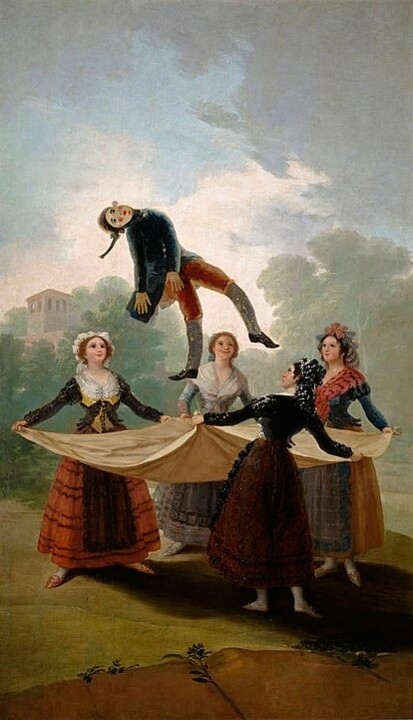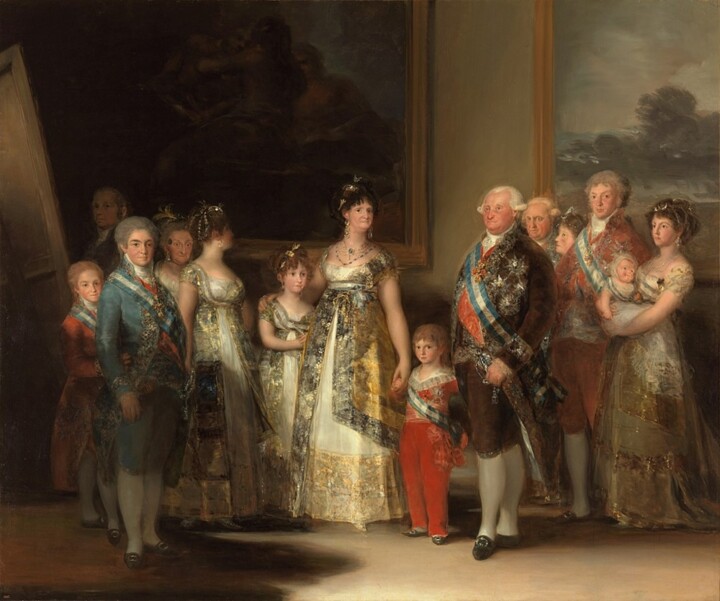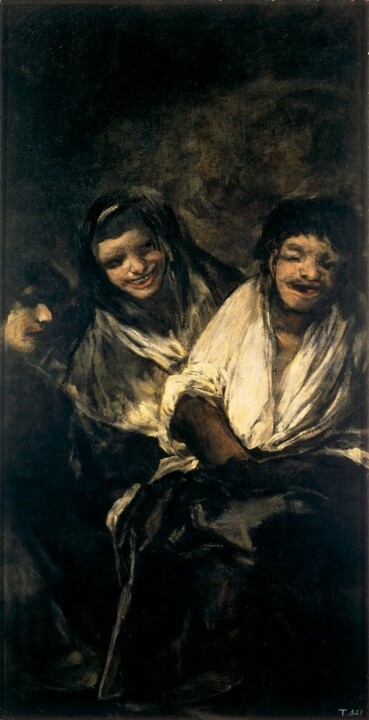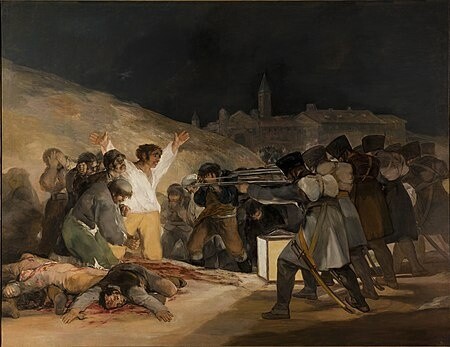 Francisco Goya, Self-portrait at an Easel, 1790-1795. Madrid: Real Academia de Bellas Artes de San Fernando.
Francisco Goya, Self-portrait at an Easel, 1790-1795. Madrid: Real Academia de Bellas Artes de San Fernando.
Who was Francisco Goya?
Francisco Goya (1746-1828) was a Spanish painter and printmaker who is widely regarded as one of the most important artists of the late 18th and early 19th centuries. Goya's work spans a variety of genres, including portraits, landscapes, historical scenes, and satirical prints.
Born in the town of Fuendetodos in Aragon, Spain, Goya studied under various painters before establishing himself as a court painter for the Spanish monarchy. He painted a number of portraits of the Spanish royal family, as well as other members of the aristocracy.
In addition to his portraits, Goya is known for his series of etchings known as "Los Caprichos," which satirized Spanish society and politics. He also created a series of paintings known as the "Black Paintings," which were executed directly onto the walls of his home and are considered some of his most powerful and enigmatic works.
Goya's work was highly influential, and he is often credited with paving the way for the Romantic movement in art. Today, his paintings and prints are considered some of the most important works of Spanish art and continue to be studied and admired by art lovers and scholars around the world.
 Francisco Goya, The Parasol, 1777. Oil on canvas, 152 x 104 cm. Madrid: Museo del Prado.
Francisco Goya, The Parasol, 1777. Oil on canvas, 152 x 104 cm. Madrid: Museo del Prado.
What are five key concepts about Francisco Goya?
- Social commentary: Goya was a master of social commentary in his art, using his paintings and prints to criticize and satirize the political and social issues of his time. His series of etchings, "Los Caprichos," is a prime example of this, as it depicts the follies and vices of Spanish society in the late 18th century.
- Technical skill: Goya was known for his technical skill as a painter and printmaker, particularly his use of light and shadow to create dramatic effects. He was also skilled at capturing the essence of his subjects, whether they were members of the royal family or everyday people.
- Dark themes: Despite his technical prowess, Goya's work often dealt with dark and disturbing themes. His series of paintings known as the "Black Paintings" are particularly haunting, depicting scenes of death and decay.
- Political upheaval: Goya lived through a period of political upheaval in Spain, including the Napoleonic Wars and the Peninsular War. His art reflects the turmoil of the time, often depicting scenes of violence and suffering.
- Artistic influence: Goya's work was highly influential and continues to be admired by artists and art lovers today. He is often credited with paving the way for the Romantic movement in art, and his legacy can be seen in the work of many later artists, including Édouard Manet and Pablo Picasso.
 Francisco Goya, Portrait of Don Manuel, 1787. Oil on canvas, 110 cm × 80 cm. New York: MET.
Francisco Goya, Portrait of Don Manuel, 1787. Oil on canvas, 110 cm × 80 cm. New York: MET.
Early years
Francisco Goya was born on March 30, 1746, in the small town of Fuendetodos, in the region of Aragon in northeastern Spain. He was the son of José Benito de Goya y Franque and Gracia de Lucientes y Salvador, both of whom worked for the local gentry.
Goya was the youngest of six children and grew up in a middle-class family. His parents were not wealthy, but they were able to provide him with an education and some exposure to the arts. Goya's father was a gilder and his mother was a seamstress, and both were supportive of their son's artistic ambitions.
Goya's family was not particularly well-connected or influential, but they were respected members of the local community. They encouraged Goya to pursue his artistic talents, and he was apprenticed to a local painter, José Luzán, at a young age.
Despite his modest upbringing, Goya would go on to become one of the most important and influential artists of his time, producing groundbreaking works that challenged artistic conventions and pushed the boundaries of what was considered acceptable in art. His early experiences and family background helped to shape his artistic vision and provided him with the foundation for the innovative and influential work that he would produce throughout his career.
 Francisco Goya, The Duchess de Alba in black, 1787. Oil on canvas, 210×148 cm. New York: Hispanic Society of America.
Francisco Goya, The Duchess de Alba in black, 1787. Oil on canvas, 210×148 cm. New York: Hispanic Society of America.
Art education
Francisco Goya's art education began in his hometown of Fuendetodos, where he was apprenticed to the local painter José Luzán. He later moved to Zaragoza, where he continued his training with another painter named Francisco Bayeu.
In 1763, Goya moved to Madrid to study at the Royal Academy of Fine Arts of San Fernando, where he studied under the painter Anton Raphael Mengs. Goya was heavily influenced by the neoclassical style that was taught at the academy, but he also developed his own style, which was characterized by loose brushwork and bold use of light and shadow.
In addition to his formal education, Goya also gained practical experience by working as a painter and illustrator for various publishers. He created illustrations for books, prints, and advertisements, which allowed him to experiment with different techniques and styles.
Later in his career, Goya would also study the work of the great masters of European art, including Velázquez, Rembrandt, and Rubens. He was particularly drawn to the works of the Venetian masters, whose use of color and light had a profound influence on his own work.
Despite his formal training, Goya was known for his willingness to experiment with new techniques and styles. He was constantly pushing the boundaries of what was considered acceptable in art, and his willingness to challenge conventions helped to establish him as one of the most innovative and important artists of his time.
 Francisco Goya, Il Fantoccio, 1791-1792. Oil on canvas, 267×160 cm. Madrid: Museo del Prado.
Francisco Goya, Il Fantoccio, 1791-1792. Oil on canvas, 267×160 cm. Madrid: Museo del Prado.
Italian influences
In 1770, Goya received a scholarship from the Academy to study in Rome. He spent time there studying the works of the great masters of European art, and he was particularly interested in the neoclassical style that was then in vogue. He also traveled to Naples, Florence, and Venice, where he was exposed to the works of the Venetian masters.
Goya's time in Italy had a profound impact on his art. He was particularly drawn to the works of the Venetian masters, whose use of color and light had a profound influence on his own work. He also began to experiment with the neoclassical style, which would later become a significant influence on his work.
One of Goya's most famous works, the painting "The Naked Maja," was created in response to the neoclassical style that he had studied in Italy. The painting caused controversy because of its depiction of a nude woman, but it also helped to establish Goya's reputation as an innovative and boundary-pushing artist.
 Francisco Goya, The Forge, 1817. Oil on canvas, 181.6 cm × 125 cm. New York City: Frick Collection.
Francisco Goya, The Forge, 1817. Oil on canvas, 181.6 cm × 125 cm. New York City: Frick Collection.
Madrid
Between 1775 and 1789, Francisco Goya established himself as a prominent artist in Madrid. During this period, he received numerous commissions from wealthy patrons and worked as a court painter for King Charles III and later for King Charles IV.
Goya's work during this period was heavily influenced by the Rococo style, which was popular in Europe at the time. He produced a number of religious paintings and altarpieces, as well as portraits of the Spanish aristocracy and royalty.
In 1783, Goya was appointed as the director of painting at the Royal Academy of San Fernando, a position he held until 1792. During his tenure, he reformed the academy's curriculum and helped to modernize the Spanish art world.
In the late 1780s, Goya's work began to show signs of a shift away from the Rococo style and towards a more realistic and personal style. This change was influenced by the political and social upheaval of the time, as well as by Goya's own personal experiences and struggles.
Overall, Goya's work during this period reflects his growing interest in exploring new artistic styles and subjects, as well as his increasing disillusionment with the social and political realities of his time. These themes would become even more pronounced in his later works.
 Francisco Goya, Apollo in the Forge of Vulcan, 1639. Oil on canvas, 223 × 290 cm. Madrid: Museo del Prado.
Francisco Goya, Apollo in the Forge of Vulcan, 1639. Oil on canvas, 223 × 290 cm. Madrid: Museo del Prado.
Goya and Velázquez
Francisco Goya was heavily influenced by the work of Diego Velázquez, one of the most important Spanish painters of the 17th century. Goya was particularly drawn to Velázquez's use of light and shadow, his ability to capture the personalities and emotions of his subjects, and his innovative use of color.
Goya's admiration for Velázquez can be seen in many of his works, including his portraits of Spanish royalty and aristocrats. Goya's portraits, like Velázquez's, are notable for their realism and psychological depth. He also emulated Velázquez's use of color and light, which can be seen in many of his works, including the famous "The Family of Charles IV" portrait.
Despite his admiration for Velázquez, Goya also sought to break away from the traditional style of Spanish painting that Velázquez had helped to establish. Goya's work was more personal and subjective than Velázquez's, and he often used his art to critique the social and political realities of his time.
Overall, Goya's work shows a deep respect for Velázquez's artistry and techniques, while also reflecting his own unique perspective and vision.
 Francisco Goya, Duello rusticano, 1820 - 1821. Oil on wall transported on canvas, 123×266 cm. Madrid: Museo del Prado.
Francisco Goya, Duello rusticano, 1820 - 1821. Oil on wall transported on canvas, 123×266 cm. Madrid: Museo del Prado.
Goya and Raimondi
Francisco Goya and Marcantonio Raimondi were both artists who worked in different time periods and in different styles, but there are some connections between their work.
Raimondi was an Italian engraver who lived in the 16th century, and he is particularly famous for his reproductions of the works of Raphael and other Italian Renaissance masters. He was one of the first artists to develop the technique of engraving, which involves etching a design onto a metal plate and then using it to print copies of the design.
Goya was a Spanish painter who lived in the late 18th and early 19th centuries. While he did not work in the medium of engraving, he was known for his use of prints and etchings to reproduce his works and disseminate his ideas.
In some ways, Goya can be seen as a successor to Raimondi, as he too used reproductive techniques to disseminate his ideas and critique the social and political realities of his time. However, Goya's work was much more personal and subjective than Raimondi's, and he used his prints and etchings to explore his own experiences and emotions.
Overall, while Goya and Raimondi worked in different mediums and styles, they both played important roles in the development of printmaking and the dissemination of art and ideas.
 Francisco Goya, The Family of Charles IV, 1800-1801. Oil on canvas, 280×336 cm. Madrid: Museo del Prado.
Francisco Goya, The Family of Charles IV, 1800-1801. Oil on canvas, 280×336 cm. Madrid: Museo del Prado.
Francisco Goya as a Court painter
Francisco Goya served as a court painter for the Spanish monarchy for much of his career. He was first appointed as a court painter to King Charles III in 1786 and later became court painter to King Charles IV in 1799.
As a court painter, Goya was responsible for creating portraits of members of the royal family, as well as other works of art for the royal palace and other official buildings. He also created works of art for other members of the Spanish aristocracy and for the Catholic Church.
Goya's portraits of the Spanish royals and aristocracy are particularly notable for their realism and psychological depth. Rather than presenting idealized and flattering images of his subjects, Goya sought to capture their personalities and emotions in a more honest and realistic way.
Goya's work as a court painter also allowed him to develop important connections in the art world and to establish himself as one of the most important artists of his time. However, he also used his art to critique the social and political realities of his time, often expressing his disillusionment with the ruling class and their policies.
Overall, Goya's work as a court painter reflects both his technical skill and his deep engagement with the social and political issues of his time. His portraits and other works of art continue to be celebrated today for their artistic merit and their historical significance.
The masterpieces created for the Spanish court
- The Family of Charles IV: This large group portrait depicts the Spanish royal family and their attendants. It is considered one of Goya's most important works and is now housed in the Prado Museum in Madrid.
- The Naked Maja and The Clothed Maja: These two paintings depict the same woman, one nude and one clothed, and are considered some of Goya's most sensual and provocative works.
- The Third of May 1808: The painting depict the Spanish people's uprising against French forces during the Peninsular War. The work is highly emotional and dramatic and it's now housed in the Prado Museum in Madrid.
- La Tauromaquia: This series of etchings depicts bullfighting and was commissioned by the Royal Academy of Fine Arts of San Fernando. The etchings are highly detailed and capture the excitement and danger of the bullfighting spectacle.
- The Burial of the Sardine: This large-scale painting was commissioned by the Royal Academy of Fine Arts of San Fernando and depicts the traditional Spanish Carnival ritual of burying a sardine. It is a highly theatrical and colorful work that reflects Goya's interest in popular culture and folklore.
 Francisco Goya, La maja desnuda, 1790-1800. Oil on canvas, 95×190 cm. Madrid: Museo del Prado.
Francisco Goya, La maja desnuda, 1790-1800. Oil on canvas, 95×190 cm. Madrid: Museo del Prado.
Masterpieces between 1790 and 1805
"Maya Desnuda" (also known as "The Naked Maja") is a painting by Francisco Goya that depicts a reclining female nude. It is one of Goya's most famous works and is notable for its realistic depiction of the female form.
The painting was completed in 1797-1800 and was likely commissioned by Manuel Godoy, a powerful Spanish politician and patron of the arts who was also a friend of Goya. It was initially considered scandalous due to its realistic portrayal of a nude woman, which was seen as inappropriate for the time.
Goya himself painted a companion piece, "Maya Vestida" (or "The Clothed Maja"), which depicts the same model wearing a flowing white gown. Completed between 1800 and 1805, "Maya Vestida" was likely commissioned by Manuel Godoy, a powerful Spanish politician and patron of the arts who was also a friend of Goya. It is considered to be a more conventional painting than "Maya Desnuda," with the model depicted in a pose reminiscent of classical Greek sculpture. Both paintings are now housed in the Prado Museum in Madrid and continue to be celebrated for their technical skill and their place in the history of Western art. "Maya Desnuda" is perhaps more famous, "Maya Vestida" is also considered to be a significant work in Goya's oeuvre.
 Francisco Goya, Maja vestida, 1790-1800. Oil on canvas, 95×190 cm. Madrid: Museo del Prado.
Francisco Goya, Maja vestida, 1790-1800. Oil on canvas, 95×190 cm. Madrid: Museo del Prado.
Life and art between 1793 and 1799
Between 1793 and 1799, Francisco Goya's work and activities were largely focused on his role as court painter to King Charles IV of Spain. During this time, he created a number of important works of art, including portraits of the royal family and other members of the Spanish aristocracy.
One of the most notable works from this period is Goya's portrait of Charles IV and his family, which was completed in 1800 and is now housed in the Prado Museum in Madrid. This large group portrait depicts the royal family and their attendants in a highly realistic and detailed manner, with Goya using subtle touches to capture their personalities and emotions.
In addition to his work as a court painter, Goya also continued to produce works of art on his own, including a number of etchings that explored social and political themes. One of his most famous series of etchings from this period is "Los Caprichos," which includes a range of satirical and critical images that comment on Spanish society and culture.
 The dream of reason produces monsters - Los Caprichos.
The dream of reason produces monsters - Los Caprichos.
Los Caprichos
Francisco Goya created "Los Caprichos," a series of 80 etchings, as a response to the social and political climate of his time. He was deeply disturbed by the corruption and injustices that he saw in Spanish society, including the abuses of the Inquisition, the superstitions of the common people, and the excesses of the aristocracy.
Through his etchings, Goya aimed to critique and expose these issues, using satire and dark humor to reveal the hypocrisy and irrationality of Spanish society. The etchings depict a range of characters, from corrupt priests to foolish nobles to everyday people caught up in their own superstitions and delusions.
"Los Caprichos" was a highly controversial work, and Goya was forced to withdraw it from public sale after only a few copies were sold. However, the series remains an important and influential work of art, showcasing Goya's technical skill and his sharp critique of the society in which he lived.
Peninsular War
The Peninsular War (1808-1814) was a conflict between France and Spain that had a significant impact on the life and work of Francisco Goya. Goya was living in Madrid at the time of the French invasion in 1808, and he witnessed the violence and chaos that ensued.
Goya's experience of the war is reflected in his later paintings, particularly those in the "Disasters of War" series. These works depict the horrors of war, including mass executions, torture, and famine. Goya's depictions are often stark and uncompromising, and they show the suffering of both soldiers and civilians.
Goya was also personally affected by the war, as he had close friends and family members who were killed or imprisoned during the conflict. His own health suffered as well, and he developed a serious illness that left him deaf.
Despite these difficulties, Goya continued to create art throughout the war and its aftermath. His later works are often more introspective and contemplative, as he grappled with the trauma of his experiences. The Peninsular War thus had a profound impact on Goya's life and art, and it remains a significant historical event in Spanish history.
 Francisco Goya, Man Mocked by Two Women, 1819–182. Oil on gesso transferred to linen, 125.4 cm × 65.4 cm. Madrid: Museo del Prado.
Francisco Goya, Man Mocked by Two Women, 1819–182. Oil on gesso transferred to linen, 125.4 cm × 65.4 cm. Madrid: Museo del Prado.
Quinta del Sordo and Black Paintings
The Quinta del Sordo was a house on the outskirts of Madrid that Francisco Goya purchased in 1819. It was here that Goya created his famous "Black Paintings," a series of dark and disturbing works that were painted directly onto the walls of the house.
The "Black Paintings" are characterized by their somber tone and often grotesque imagery. They include works such as "Saturn Devouring His Son," "Witches' Sabbath," and "Fight with Cudgels." Some of the paintings are thought to have been inspired by Goya's own fears and anxieties, while others may have been responses to the political and social turmoil of the time.
The paintings were not meant to be seen by the public; rather, they were a private expression of Goya's innermost thoughts and emotions. Goya himself referred to them as his "pinturas malditas" or "cursed paintings." After Goya's death, the paintings were removed from the walls of the Quinta del Sordo and transferred to canvas.
Later years
In his later years, Francisco Goya continued to produce art despite his failing health. He moved to Bordeaux, France in 1824, where he lived until his death in 1828. During this time, he created a number of works that are now considered among his most important.
Goya's time in Bordeaux was marked by personal tragedy, as his wife Josefa Bayeu died in 1818, followed by his son Javier in 1823. Despite these losses, Goya continued to work and even became something of a celebrity in French artistic circles.
Goya's last major project was a series of lithographs known as the "Tauromaquia," which depict bullfighting scenes. The series was completed in 1825, and it marked a return to the themes and subjects that had preoccupied Goya throughout his career.
Goya died on April 16, 1828, at the age of 82. His remains were interred in Bordeaux, but they were later transferred to the Royal Chapel of San Antonio de la Florida in Madrid, where he had painted a series of frescoes earlier in his career.
What are Francisco Goya's most famous works?
- The "Black Paintings" - a series of dark and disturbing works created on the walls of his house.
- The "Disasters of War" - a series of prints depicting the horrors of the Peninsular War.
 Francisco Goya, The Third of May 1808, 1814. Oil on canvas, 268×347 cm. Madrid: Museo del Prado.
Francisco Goya, The Third of May 1808, 1814. Oil on canvas, 268×347 cm. Madrid: Museo del Prado.
- "The Third of May 1808" - a painting depicting the execution of Spanish citizens by French soldiers during the Peninsular War.
- "La maja desnuda" and "La maja vestida" - portraits of a nude and clothed woman, respectively.
- "The Sleep of Reason Produces Monsters" - an etching from the "Los Caprichos" series that critiques superstition and ignorance.
- "The Family of Charles IV" - a group portrait of the Spanish royal family.
- "The Nude Maja" - a provocative portrait of a reclining nude woman.
 Francisco Goya, The Colossus, 1808. Oil on canvas, 116 × 105 cm. Madrid: Museo del Prado.
Francisco Goya, The Colossus, 1808. Oil on canvas, 116 × 105 cm. Madrid: Museo del Prado.
- "The Colossus" - a painting depicting a giant man standing over a landscape.
 Francisco Goya, Saturn Devouring His Son, c. 1819–1823. Oil on canvas, 143.5 × 81.4 cm. Madrid: Museo del Prado.
Francisco Goya, Saturn Devouring His Son, c. 1819–1823. Oil on canvas, 143.5 × 81.4 cm. Madrid: Museo del Prado.
- "Saturn Devouring His Son" - a haunting painting from the "Black Paintings" series.
 Francisco Goya, The Burial of the Sardine, c. 1812–1819. Oil on wood, 82.5 cm × 62 cm. Madrid: Real Academia de Bellas Artes de San Fernando.
Francisco Goya, The Burial of the Sardine, c. 1812–1819. Oil on wood, 82.5 cm × 62 cm. Madrid: Real Academia de Bellas Artes de San Fernando.
- "The Burial of the Sardine" - a festive scene depicting a carnival tradition.


 Selena Mattei
Selena Mattei





